

Street Directory of Commercial Road, south side, 1921
Commercial
Road was laid out in 1802-06 to provide a direct route between the City
and the new docks on the Isle of Dogs; the western end, previously
known as White Horse Lane, was added in 1869-70 to join Whitechapel
Road. It forms the northern boundary of the present and its former
constituent parishes, from the junction with Whitechapel High Street in
the east, so only the south side of the street is included here.
However, this list goes further east than the parish boundary, up to
Albert Square, to include a number of places of relevance to our parish
story, such as the SPCK college and St John's Vicarage. Underlining denotes names and/or trades at the same premises in the 1899 Directory, and *asterisks* those in the 1956 Directory: apart from
the pubs and beer-selling premises, some tobacconists and doctors'
surgeries, the continuity is limited. Trades and businesses are
predominantly Jewish-run [see this 1894 trade directory], with some Irish presence further east. The
number of bankruptcies is high, though most appear to have bounced back.
In the 19th century, some stretches of the street were numbered as
short terraces: from west to east along the south side, King's Place,
Princes Place, Nassau Place, Waterloo Place, Evaline Place, Devonshire Place and Colet Place. (On
the north side were Langley Place, Hereford Place, Northumberland
Place, Bedford Place, Upton Place and Crombies Row.) Hence some of the changes of
address below.
See this 1932 article by Sydney Maddocks. The transcription is partly based on this excellent website.
| 2 [Wheatsheaf Tavern], Edwin Sable, beer retailer [1] 4 *Joseph McMillan*, trunk maker 6 George Byford & Co, hosiers [2] 6 Jackson & Ellis, artificial teeth manufacturers [3] 8 Gambro Ltd, coffee rooms [4] 10 *Charles Sabel, tobacconist* 12-16 Capital & Labour Clothing Association [5] ... here is Plough Street ... 18 William Straker Ltd, stationers 20 Israel Eichenbaum, warehouseman [6] 22 S Lewis & Co, wholesale confectioners [7] 22 F H Rake Ltd, builders 24 Samuel Jacobs, boot & shoe factor 26 Wilson Bros Ltd, fine art publishers [8] 28 & 28A J Wix & Sons, tobacco manufacturers [9] 30A A & R Levy Ltd, Manchester warehousemen [10] 30B Rischel & Joseph Kern, woollen warehousemen 30B Joseph *Liggins, coffee rooms* [4] 30 Nathan Steingold, jeweller 30 Willis & Willis, hay salesmen [11] 32 *J J & S W Chalk, timber merchants* [12] 34 Israel Solomon, draper 36 S & B Zanorotsky, ladies underclothing manufacturers 38-40 London Salvage Corps, A J Jones, superintendent [13] 42 William Watson, farrier [11] 44 *Castle*, Simon Rosenthal [1] ... here is Goodmans Stile ... 46 Port of London Authority (town warehouse) [14] Midland Railway (London, Tilbury & Southend section) - *Goods Depot*, Ernest Falconer, London outdoor goods manager 46-50 *Gunmakers Company's Proof House*, William Huxell, gun barrel proof master [6] 46 *Gunmakers Hall: Gunmakers Company*, Douglas Cameron Lee, clerk [6] ... here is Gowers Walk ... 52 Cohen, Weenen & Co, tobacco manufacturers [9] 54-58 Joseph Tetley & Co Ltd, wholesale tea dealers [15] 56 Cave, Johnson & Co Ltd, wholesale tea dealers [15] 54 Fairclough Bros, wheelwrights [16] *Improved Industrial Dwellings Co Ltd (Morrison buildings south)* [17] ... here is Back Church Lane ... 62 Boundary Tavern, Myer Calchman [1] 64 Morris Polakoff, mohel [18] 64 Holliday & Co, scale makers 66 Emanuel Bach, fruiterer 68 Murray & Laker, custom house agents [19] 70 Morris Pockler, ladies blouse maker 72 Hyman Cohen, confectioner [7] 74 Harris Wieselberg, stationer 76-8 Henry Shaw, photographer [20] 80 Hildebrand & Co, wholesale milliners [21] 82 Pomarantz & Duransky, printers [22] ... here is Berner Street ... 84 Lewis Samuel, woollen merchant 86 Abraham & Harry Meltzer, boot & shoe factors 88 Joseph Wodislawsky, *wine merchant* [23] Jewish Synagogue [18] 90 Harry Pilz, hairdresser 92 Hyman Fabian, button & trimming seller 94 Jacob Stern & Co, passenger agents 96 Sigmund Furer, tailor 98 Hyman Shepherd, blouse manufacturer ... here is Batty Street ... 100 Samuel Leon Spigner, physician & surgeon [24] 102 Morris Petrikoski, butcher [25] 104 Elijah Francis Goff, beer retailer [1] 106 I Kahan & Co, shipping agents [26] 108 Jacob Cash, boot maker 110 Lewis Klein, tobacconist 112 Aron Porter, plumber 114 Joseph Press, *restaurant* [4] ... here is Christian Street ... 116 George Bliss, *pawnbroker* 118 Oscar Baumgart, photographer [20] 122 *J W Bland & Sons, wholesale stationers* [27] 124 Israel Metz, furniture dealer [28] 126 Mrs Ray Ross, milliner [29] 126 Judah Solomons, *ladies tailor* |
128 *King's Head*, David Bloom [1] ... here is Grove Street ... 130 Israel Barnett, leather seller ... here is Golding Terrace ... 136 Joseph Goide, baker [7] 138 Benjamin *Bartzman, tobacconist* [30] 138 Miss Bessie Bartzmann, milliner ... here is Umberston Street ... 140 Dagmar Arms, Frederick C Ivermee, beer retailer [1] 142 Miss Dora Rose, milliner 144 Gabriel Bomzer, confectioner [7] 146 Mrs Betsy Iserlies, midwife [18] 146 Abraham Chesler, fruiterer 148 Jacob *Wolfryd*, restaurant [4] 150 Abrahams Hyman, *woollen merchant* 152 Miss Ray Gold, milliner 152A *Stebbing & Co, boot & shoe factors* [31] ... here is Hessel Street ... 154 Joseph Morris, printer [22] 156 Philip Rush, *tobacconist* 158 *Mackworth Arms*, Simon Koski [1] ... here is Cannon Street Road ... 162 *Louis Frumkin & Co, wine & spirit dealers* [23] 164-6 Marks Luck, hosier 168 Mrs Esther Greenberg, tailor 168 Marks Rabin, tailor 170 Bernhard Morris, physician & surgeon [24] 172-4 S Krayer, ladies underclothing manufacturer [32] ... here is Little Turner Street ... 176 Joseph Rabinovitch, provision merchant 178 Woolf Krause, artificial teeth maker [3] 180 Alick Brass, ladies tailor [33] 182 Samuel Rosen, corset maker 184 Morris Hackman, woollen merchant 186 Alexander Bressloff, furrier 188 [also 416] Morris Zelman Bochenek MB surgeon [24] 190 Albert Ross, boot maker 192 Lewis Newsbaum, baker [7] ... here is Richard Street ... 196-8 Percy Young, furniture dealer [28] 200 Oseas Rosenfeld, fancy draper [34] 202 Samuel Marks, newsagent 204 *Joseph Dudack, trimmings seller* 206 Miss Florrie Rosen, milliner 208 *Simon Tolovinsky, printer* [22] ... here is Jane Street ... 210-6 *Lloyds Bank Ltd*, Alan A R Geren, manager [5] 210 [Bank House] Rev Thomas Rose Couch [36] 218 Mrs Annie Perse, confectioner [7] 220-2 Harris Lipshitz, job buyer 224 Daniel Kolskey, tobacconist ... here is Anthony Street ... 226 *Palaseum Ltd, cinematograph theatre* [37] ... here is Fenton Street ... 228 Mendel Chaikin & Co, wine & spirit merchants [19] 228A Nathan Goldstein, woollen merchant 230A Garvis Harris, ladies tailor 230A Miss Pearl Harris, milliner 230 *Lord Nelson*, Mendel Monk [1] ... here is Buross Street ... 232 Isaac Michaels, *tobacconist* 234 Harry Bloom, provision dealer 236 *Abraham Rapoport*, piece broker 238 Davis Benjamin, fruiterer 238A William H Neighbour, florist 240 Hungerford Arms, John A Lovegrove, beer retailer [1] ... here is Hungerford Street ... 240A L Isaacs & Sons, wholesale tailors 242 John Byford & Son Ltd, builders merchants [38] 242 George Butler, builder 246 Francis Maybury, carman 248 Nathan *Diamondstein & Sons, tobacconists* [39] 250 Robert William Starling, beer retailer [1] ... here is Planet Street ... 252 Samuel Gees, watchmaker 254-6 Lewis Stinnerman, ladies underclothing manufacturer 258 Morris Finesilver, boot repairer 260 *Harris Skolnik, woollen merchant* ... here is Winterton Street ... |
264 [later 238] *Morris Glickman & Son, ironmongers* [40] 266 Victory, William Francis Trawley, *beer retailer* [1] ... here is Watney Street ... 270 Vine & Scott, tailors 272 Samuel Berlin, ladies tailor 274 Lillo Saitta, music teacher [41] 276 John George Cook, estate office 282 George Merritt, relieving officer [42] 284 Bakhshi Isaac Rahim, physician & surgeon [24] 286 Mrs Rachel W Schechman, midwife [18] 288 Bernard Bernstein, tailor 290 Philip Woolfson, woollen merchant [43] 292 Nathan Posner, tailor 296 Bernard Baker, mantle maker ... here is Dean Street ... 300 Rev Samuel Kelman Melinek [44] 310 Mrs Mary Nathanson, dress maker 314 Jerome Reidy MD, surgeon [24] 318 Schwartz & Black, dress makers 328 Convent of the Little Company of Mary, nursing sisters, Rev Mother de Sales, superior [45] 330 Samuel Chutner, *artificial teeth maker* [3] 334 Moss & Gray, valuers [46] ... here is Sutton Street ... 336-8 James Walker & Sons, bakers [7] 340-2 Frost Bros Ltd, rope makers [47] *St Mary & St Michaels (Catholic) Church* [48] 342 Mrs Fanny Fruchyman, blouse maker 346 Meyer Gross, tobacconist ... here is Lucas Street ... 348 Miss Jane Catherine Hodge, *beer retailer* [1] 350 A Schwalbe, cap manufacturer 352 (& 456,699,741) George M Stephens, *dining rooms* [4] 354 (& 27 & 543) *Edmund R Goodrich Ltd, grocers* [49] 356 David Feller, watch maker 358 Jonas Franklin, provision dealer 360 William George Carter, newsagent 362 Samuel Casper, boot & shoe manufacturer 364 Woolf Cohen & Son, trousers makers 366 Isaac Taylor, greengrocer ... here is Johnson Street ... 368 Barclays *Bank* Ltd, Frank Lucas, manager [35] 368 Edmund John Eagles 370 Charles Crawley, barge owner [50] 372 John William Lynch, surgeon [24] 376 Nathan Avriskt, hairdresser 376 Mrs Morris Elsmar, butcher ... here is Hardinge Street ... 378 William Henry Godier, fishmonger 380 John Allpress, beer retailer [1] 382 Edward Coleman, confectioner [7] 384-392 Church Training College for Lay Workers, Rev Charles John Beresford MA, warden [51] 394-8 *East End Mothers Lying-in Home*, Miss Anderson, lady superintendent [52] 400 Rev Hastings Leonard Langley AKCL (St Johns Vicarage) [53] 402 George Morton & Son, travelling drapers 404 Joseph Hugh Arthur MD, surgeon [24] 406 Arthur Tolani, confectioner 408 Peter Dennison, cowkeeper [11] 410 Robert Mitchell & Co, corn dealers 412 Isaac Werbner, chandlers shop 414 Mrs Maria Phoebe Frost, *beer retailer* [1] ... here is Devonport Street ... 416 Morris Zelman Bochenek MD, surgeon [24] 418 Joseph Blackman, underclothing manufacturer 420 Aaron Dubowski & Sons, chandlers shop ... here is Havering Street ... 422 Isaac Courts, tailors trimmings seller 424 Frederick William Peirson, insurance agent 428 Nathan Koritski, tailor [54] 430 Brown & Lipman, mantle makers 432 Jacob Pell, tailor 434 M & A Woolf, general merchants [55] ... here is Albert Square ... |
[1] Public houses and beer sellers (see this list of all licensed premises in the St George-in-the-East district, and an early 20th century map by the London London United Temperance Council of all pubs in the area). Some
premises had no name. Extant buildings are numbered in these pictures:
2 Wheatsheaf Tavern, demolished for road widening; Edwin Sable died in 1932 and his widow Alice Elizabeth took over the licence.
44 Castle - one of the few to survive; fingerboards on the exterior point towards, and give distanes to, places in Ireland.
62 Boundary Tavern - previous address 1 King's Place, now demolished
104 previous address 9 King's Place
 128 King's Head,
previous address 21 King's Place; David Bloom, a Russian subject
from Poland, was the tenant from 1900 until his death in 1926, and he
and his wife, five children and mother, plus several nieces and
nephews, lived above. It closed in 2000 and now houses a clothes shop and a business school.
128 King's Head,
previous address 21 King's Place; David Bloom, a Russian subject
from Poland, was the tenant from 1900 until his death in 1926, and he
and his wife, five children and mother, plus several nieces and
nephews, lived above. It closed in 2000 and now houses a clothes shop and a business school.
140 Dagmar Arms
- named to mark the wedding of Danish Princess Marie Dagmar to future
Tsar Alexander III. Frederick Charles Ivermee had served as a corporal
in the War and received the Silver War badge (also known as the
'discharge', 'wound' or 'services rendered' badge - right)
to mark his honourable discharge due to wounds or sickness. One purpose
for issuing them was to prevent women giving white feathers to
apparently able-bodied civilians.

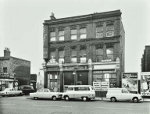 158
Mackworth Arms, previous address 10 Princes Place: Simon Koski [Kosky]
was the landlord in 1921, with his wife Nancy; his successor from 1923 was
Nathan(n) Dubosky, whose wife always had
a plentiful supply of latkes on the counter, so it was known as 'Latke
House'. It later became a Watney's house, and closed in 1984. The ground floor is now a clothing shop. Left - an interior view.
158
Mackworth Arms, previous address 10 Princes Place: Simon Koski [Kosky]
was the landlord in 1921, with his wife Nancy; his successor from 1923 was
Nathan(n) Dubosky, whose wife always had
a plentiful supply of latkes on the counter, so it was known as 'Latke
House'. It later became a Watney's house, and closed in 1984. The ground floor is now a clothing shop. Left - an interior view.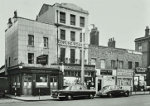 240 Hungerford Arms - right in 1963, also showing Glickmans at 238
240 Hungerford Arms - right in 1963, also showing Glickmans at 238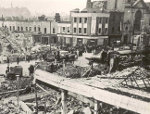 266 Victory - the surrounding area was blitzed 1941 [left] but it survived into the 1960s
266 Victory - the surrounding area was blitzed 1941 [left] but it survived into the 1960s
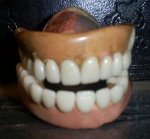 [3] There were three listed as teeth makers (and dentists) in this stretch of the road (and several others earlier in the century):
[3] There were three listed as teeth makers (and dentists) in this stretch of the road (and several others earlier in the century):
Louis Jackson and Isadore Ellis were in partnership as Jackson & Ellis, dentists at no.6 until Ellis its dissolution in 1923, Jackson continuing the business.
Woolf Krause
at no.178 was born around 1866 in Russia; he lived over the shop with Helen,
Isidore and Myer. Working as a dentist, in 1892 he began to make
gumshields for boxers, made from stips of gutta percha, a natural
rubber resin. His son Phillip, an amateur boxer, is said to have made
the first reusable gumshield; his schoolfriend Ted 'King' Lewis was the first professional to use it.
Samuel Chutner at no.330, possibly né Šams Cetnor, died in 1936 at Wentworth Road, Golders Green.
 [5] The Capital & Labour Clothing Association
sounds like a Co-op related venture, but it was the business of
clothier Joseph Edwin Halliday, begun around 1880. The main branch was
in Waterloo [left]; others
followed, in Croydon, Holloway, Tottenham Court Road and Commercial
Road. Its 1892 Christmas annual included a short story, The Rajah's Diamond,
by Robert Louis Stevenson, and a poem by Kipling. It made the
extravagant claim of being the largest firm of manufacturing clothiers
in the world. Halliday evidently recovered from a bankruptcy in 1911;
branches had opened in other towns, including Sheffield, and
Southampton, where they advertised as merchant tailors, yacht outfitters, school and college clothing of reliable quality at keenest prices; in the 1920s they won a clothing contract for its tramway staff.
[5] The Capital & Labour Clothing Association
sounds like a Co-op related venture, but it was the business of
clothier Joseph Edwin Halliday, begun around 1880. The main branch was
in Waterloo [left]; others
followed, in Croydon, Holloway, Tottenham Court Road and Commercial
Road. Its 1892 Christmas annual included a short story, The Rajah's Diamond,
by Robert Louis Stevenson, and a poem by Kipling. It made the
extravagant claim of being the largest firm of manufacturing clothiers
in the world. Halliday evidently recovered from a bankruptcy in 1911;
branches had opened in other towns, including Sheffield, and
Southampton, where they advertised as merchant tailors, yacht outfitters, school and college clothing of reliable quality at keenest prices; in the 1920s they won a clothing contract for its tramway staff.
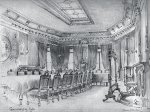
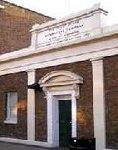
 [6] The Gunmakers' Company Proof House [left & right] at
46-50 Commercial Road, remains a working institution. Gunmaking had long been a major local trade,
centred in the area east of the Tower and in Saltpetre Bank [now Dock
Street], with many specialist workshops throughout the area. The
Office of Ordnance (based near the Minories) regulated the supply of
arms and gunpowder to the Army, and ran its own foundry. The
Blacksmiths' and Carpenters' Companies both tried to dominate the
trade, but in 1638 the Worshipful Company of Gunmakers
was given a charter, naming 125 local gunmakers. Although a city livery
company, it was banished from the City because of its hazardous work.
The original proof house, for testing shotguns, was near Tower Hill
but relocated to its present site in 1675, where it was rebuilt after
damage caused by explosions in 1757 (and continues in use for testing and
marking small arms gun barrels). More detail in Derek Morris & Ken Cozens Wapping 1600-1800 (East
London History Society 2009), which also includes concerns voiced about
the storage of gunpowder in the area in the late 17th century. The
Company's Archivist, Derek Stimpson, edited the Company's official
history as The Worshipful Company of Gunmakers: A History (London 2008), and there is a history of its buildings in issue 18 of its newsletter Lock, Stock & Barrel.
The Hall to the right of the Proof House was built in 1870 at a
cost of £2,143 plus £1,377 for furniture and fittings [original interior right], but in the harsh
climate of the 1920s it was sold to Israel Eichenbaum and Pinkus Segalov
and was used for various purposes until the Gunmakers managed to buy it
back for £1.1m; it is leased to a church charity until 2015.
[6] The Gunmakers' Company Proof House [left & right] at
46-50 Commercial Road, remains a working institution. Gunmaking had long been a major local trade,
centred in the area east of the Tower and in Saltpetre Bank [now Dock
Street], with many specialist workshops throughout the area. The
Office of Ordnance (based near the Minories) regulated the supply of
arms and gunpowder to the Army, and ran its own foundry. The
Blacksmiths' and Carpenters' Companies both tried to dominate the
trade, but in 1638 the Worshipful Company of Gunmakers
was given a charter, naming 125 local gunmakers. Although a city livery
company, it was banished from the City because of its hazardous work.
The original proof house, for testing shotguns, was near Tower Hill
but relocated to its present site in 1675, where it was rebuilt after
damage caused by explosions in 1757 (and continues in use for testing and
marking small arms gun barrels). More detail in Derek Morris & Ken Cozens Wapping 1600-1800 (East
London History Society 2009), which also includes concerns voiced about
the storage of gunpowder in the area in the late 17th century. The
Company's Archivist, Derek Stimpson, edited the Company's official
history as The Worshipful Company of Gunmakers: A History (London 2008), and there is a history of its buildings in issue 18 of its newsletter Lock, Stock & Barrel.
The Hall to the right of the Proof House was built in 1870 at a
cost of £2,143 plus £1,377 for furniture and fittings [original interior right], but in the harsh
climate of the 1920s it was sold to Israel Eichenbaum and Pinkus Segalov
and was used for various purposes until the Gunmakers managed to buy it
back for £1.1m; it is leased to a church charity until 2015.
Israel Eichenbaum
(1874-1935, married to Fanny) had a warehouse along the road at no 20
(he registered its freehold in 1927). He dealt in towels, curtains and
bedding.
[7] Confectioners, bakers & caterers
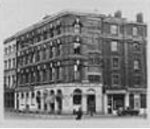 Confectioners
tended to be German - like sugar-baking, it was a trade they brought to
the East End, and there had been many more at the end of the previous
century. Some, like nos.72, 144 (Gabriel Bomzer, 1873-1926, married to Annie - presumably related to Barnett Bomzer of Cable Street),
218 and 282, were small sweet or cake shops; S. Lewis at no.22 was a
wholesale supplier. There were bakers at nos.192 - Lewis Newsbaum (previously run by Joseph Himpfen) and 336 - James Walker & Sons (long-established).
Confectioners
tended to be German - like sugar-baking, it was a trade they brought to
the East End, and there had been many more at the end of the previous
century. Some, like nos.72, 144 (Gabriel Bomzer, 1873-1926, married to Annie - presumably related to Barnett Bomzer of Cable Street),
218 and 282, were small sweet or cake shops; S. Lewis at no.22 was a
wholesale supplier. There were bakers at nos.192 - Lewis Newsbaum (previously run by Joseph Himpfen) and 336 - James Walker & Sons (long-established).
At no.136 was
Joseph Goide
(1866-1946) who came from Russia in the 1880s and set up a grocer's shop in
Brady Street in 1889, and baker's shops in Commercial Road (previously run by Jacob Kutchinsky) and
Spitalfields, and also Wardour Street in the West End. In 1938 (when he
was living at Seven Sisters, and described as restaurant proprietor
and confectioner) a receiving order was made on 'J Goide Caterers' at
54 Whitechapel High Street, where they had a banqueting hall for
weddings and bar mitzvahs,
but it recovered, and his grandsons Richard and Alan took it on after
his death, moving catering to the Royal Majestic Suite in Willesden. Right are their 1955-84 Commercial Street [sic] premises.
[9] There were three tobacco manufacturers with premises locally as well as elsewhere.
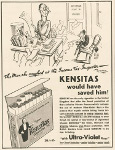
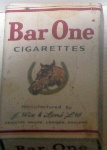
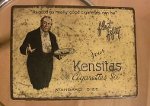 Julius
Wix (1860-1933), born in Russia, worked in a tobacco factory from the
age of 10, and came to London in 1889, working as a cutter and blender
for various firms - he was the original blender of 'Pick-me-ups' and
'De Reske Tenor' - and became a partner in Major Drakin & Co
before selling his intrest and setting up his own company, J. Wix & Sons,
in 1901, initially in Buckle Street, Whitechapel and then at Commercial
Road (with a branch in Piccadilly); later the head office was at
various addresses in Old Street, with factories at Livingstone Road E15
and Hurst Green. His most famous brand, still in production
(marketed by Gallaher since 1961), was Kensitas, which controversially
was for a time marketed as a 'healthy' cigarette [far right]. He retired in
1927, selling up to the American Tobacco Company. In 1933 his son
Abraham, who had been managing director, attempted to register 'Wix' as
a trademark in the USA, but this was rejected as it was held to be a
name rather than a product.
Julius
Wix (1860-1933), born in Russia, worked in a tobacco factory from the
age of 10, and came to London in 1889, working as a cutter and blender
for various firms - he was the original blender of 'Pick-me-ups' and
'De Reske Tenor' - and became a partner in Major Drakin & Co
before selling his intrest and setting up his own company, J. Wix & Sons,
in 1901, initially in Buckle Street, Whitechapel and then at Commercial
Road (with a branch in Piccadilly); later the head office was at
various addresses in Old Street, with factories at Livingstone Road E15
and Hurst Green. His most famous brand, still in production
(marketed by Gallaher since 1961), was Kensitas, which controversially
was for a time marketed as a 'healthy' cigarette [far right]. He retired in
1927, selling up to the American Tobacco Company. In 1933 his son
Abraham, who had been managing director, attempted to register 'Wix' as
a trademark in the USA, but this was rejected as it was held to be a
name rather than a product.
Their
cigarette cards and silks are 'collectibles' - including the 1932 set
of 'Love Scenes from Silent Movies', the 1934 set
of 60 national flags, and five sets of 'Henry's Adventures' 1935-37 by
cartoonist Carl Anderson (50 in each), issued in Britain and the USA,
plus (later) the flower silks. There are many websites showing these!
These strange words come in a letter Kenneth Tynan wrote to Elly Hotovitz in 1948:
| I looked at a packet of Kensitas this evening (a sorrowful man's eyes
rarely leave the table-cloth, and this packet was lying on a table in
the Taj), and, reading the label, I discovered what I wished
desperately to be. The label bore the manufacturer's name - J. Wix and
Sons, Limited'. O to be J. Wix, or any of his myriad sons - for they
are all limited! O to be limited, not to want to expand and embrace and
belong to multitudes! to know one's sphere, and hold sway within it
unmolested! How good that would be, how tranquil! For my world, the
small soapy puffball I am at such pains to bear, needs another pair of
hands to support it - it needs you, its joint Atlas. |

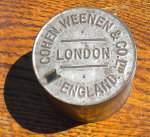
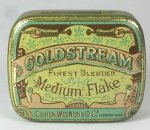
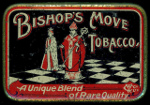
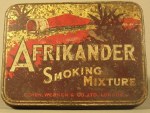 Cohen Weenan & Co was established in 1864, originally in Browns
Lane, Spitalfields. It was relatively small - in 1897 they had three
commercial travellers, against Wills of Bristol's thirty. In 1874 they took
their staff on a road excursion to Rye House: A
substantial dinner was provided by the firm, who furnished a band for
the enjoyment of the excursionists. A display of fireworks terminated
the day's enjoyment. One of their brands was Afrikander - images of its registered trademark right - they were in court over such
issues on several occasions, e.g. R. v. Cohen, Weenan & Co, Times
3 May 1899].
Cohen Weenan & Co was established in 1864, originally in Browns
Lane, Spitalfields. It was relatively small - in 1897 they had three
commercial travellers, against Wills of Bristol's thirty. In 1874 they took
their staff on a road excursion to Rye House: A
substantial dinner was provided by the firm, who furnished a band for
the enjoyment of the excursionists. A display of fireworks terminated
the day's enjoyment. One of their brands was Afrikander - images of its registered trademark right - they were in court over such
issues on several occasions, e.g. R. v. Cohen, Weenan & Co, Times
3 May 1899].


 They
produced cigarette cards from 1891-1923, including football players
(the first a set of
60 in 1907) and 'Wonders of the World' cards in 1923), but also
'Beauties',
'Actresses', 'Home & Colonial Regiments', 'Heroes of Sport',
'Famous Boxers' and 'Nations (Descriptive)'; again, many websites show
these.
It became a limited company in 1927, but (with a paid-up capital of
£700,000) was taken over in 1931 by Godfrey Phillips. That same year in
the USA
the Virginia Supreme Court of Appeals, in the case Southern Railway Co. v. Cohen Weenan, held that rainfall damage, in the storms of 1927, to stored tobacco was an Act of God, defined thus: An
act of God, as the term is known to the law, is such an unusual and
extraordinary manifestation of the forces of nature that it could not
under normal conditions have been anticipated or expected. However, the
occurrence need not be unprecedented. If it could not have been
anticipated or expected under normal conditions, that is sufficient.
The question of precedent, therefore, relates to the matter of
reasonable anticipation and opportunity to avert the consequences, and
it is in that sense that the term 'unprecedented' is used with regard
to the nature of the catastrophe. The company went into voluntary liquidation in 1962.
They
produced cigarette cards from 1891-1923, including football players
(the first a set of
60 in 1907) and 'Wonders of the World' cards in 1923), but also
'Beauties',
'Actresses', 'Home & Colonial Regiments', 'Heroes of Sport',
'Famous Boxers' and 'Nations (Descriptive)'; again, many websites show
these.
It became a limited company in 1927, but (with a paid-up capital of
£700,000) was taken over in 1931 by Godfrey Phillips. That same year in
the USA
the Virginia Supreme Court of Appeals, in the case Southern Railway Co. v. Cohen Weenan, held that rainfall damage, in the storms of 1927, to stored tobacco was an Act of God, defined thus: An
act of God, as the term is known to the law, is such an unusual and
extraordinary manifestation of the forces of nature that it could not
under normal conditions have been anticipated or expected. However, the
occurrence need not be unprecedented. If it could not have been
anticipated or expected under normal conditions, that is sufficient.
The question of precedent, therefore, relates to the matter of
reasonable anticipation and opportunity to avert the consequences, and
it is in that sense that the term 'unprecedented' is used with regard
to the nature of the catastrophe. The company went into voluntary liquidation in 1962.
(At the turn of the century, though not listed above, Joseph Michael Sullivan had been active as a wholesale tobacconist at
nos.76-78 - in partnership with Walter Clark until 1885 - and the area
behind their premises, known as Sullivan's Yard, was used during the
Second World War for fireguard exercises. William J Harris & Son were listed as tobacco manufacturers at 84-86; and at no.426 Simon Garber was a cigar manufacturer.)
[10] A Manchester warehouseman bought and sold cotton goods. (See here for an example of a 'Birmingham and Sheffield warehouseman.)

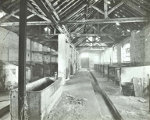 [11]
Local provision for horses was needed even in the 1920s, so there was a
hay dealer at no.30, and a farrier at no.42. Willis & Willis was originally a partnership between William
Lerwill, Frederic Harvey and Arthur Willis, dissolved in 1904 by 'effluxion
of time' as laid down by their deed of partnership. They had operated from no.36 and from the Whitechapel Hay
Market as hay and straw merchants, and in 1899 shared the premises with a corn dealer. In 1902 Arthur Willis' other partnership also ended: he worked with Herbert Havet Smith as 'J Gunn & Co (late
Whitmore)' at Florida Street, Bethnal Green as hay, straw, corn and seed
merchants.
William Watson, farrier, occupied premises which in 1899 had housed Thomas Watson (presumably a relative), veterinary surgeon. As the picture left from
further along Commercial Road shows, at that time the two trades ran
hand-in-hand. There were also still dairies and cows in the area -
hence Peter Dennison, cowkeeper, at no.408 (though another, at no.218 earlier in the century,
had gone). Right is a cowshed at 18 Fairclough Street in 1947.
[11]
Local provision for horses was needed even in the 1920s, so there was a
hay dealer at no.30, and a farrier at no.42. Willis & Willis was originally a partnership between William
Lerwill, Frederic Harvey and Arthur Willis, dissolved in 1904 by 'effluxion
of time' as laid down by their deed of partnership. They had operated from no.36 and from the Whitechapel Hay
Market as hay and straw merchants, and in 1899 shared the premises with a corn dealer. In 1902 Arthur Willis' other partnership also ended: he worked with Herbert Havet Smith as 'J Gunn & Co (late
Whitmore)' at Florida Street, Bethnal Green as hay, straw, corn and seed
merchants.
William Watson, farrier, occupied premises which in 1899 had housed Thomas Watson (presumably a relative), veterinary surgeon. As the picture left from
further along Commercial Road shows, at that time the two trades ran
hand-in-hand. There were also still dairies and cows in the area -
hence Peter Dennison, cowkeeper, at no.408 (though another, at no.218 earlier in the century,
had gone). Right is a cowshed at 18 Fairclough Street in 1947.
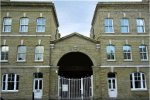 [12] The firm of James Jabez and Seymour William Chalk, timber merchants and exporters,
was established in 1882 with premises at 32 Commercial Road (Riga House) and Finland
House/Wharf, Church Row [now Newell Street] Limehouse. James Jabez died
in 1899, at his home in Leytonstone, and a succession of Seymour Chalks
continued to run the business until 1974 (others Chalks were
solicitors). The premises are now gated residential flats. known as Riga Mews.
[12] The firm of James Jabez and Seymour William Chalk, timber merchants and exporters,
was established in 1882 with premises at 32 Commercial Road (Riga House) and Finland
House/Wharf, Church Row [now Newell Street] Limehouse. James Jabez died
in 1899, at his home in Leytonstone, and a succession of Seymour Chalks
continued to run the business until 1974 (others Chalks were
solicitors). The premises are now gated residential flats. known as Riga Mews.

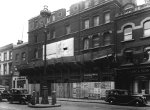
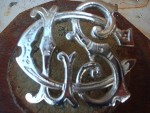 [13] The London Salvage Corps,
copying a body formed in Liverpool in 1842, was set up by John Brookes
Johnston of the Royal Insurance Comapny in 1865. Its purpose was to
reduce the loss and damage caused by fires, to mitigate the
effects of fire and fire-fighting and to salvage fire-damaged premises
and goods. Its staff of 64 increased to over 100 by the early 20th
century; many were ex-naval men, including David Jacob Blazer, a weightlifter dubbed 'Britain's Best-Developed Man'.
The headquarters were strategically placed around the capital: no.1
station, the headquarters, at Watling Street, to cover the City and the
Thames (B district); no.2, at Commercial Road, to cover east and
north-east London (C district); no.3, on Southwark Bridge Road,
opposite the fire station, to cover south London (D district); no.4, at
Shaftesbury Avenue, to cover the West End and Kensington (A district);
and no.5 in Upper Street Islington. In 1934 the service was accused of
participating in a criminal arson scandal which took £½m in false
insurance claims; Leopold Harris at his trial testified that he had had
nearly every Salvage Corps officer 'in his pocket'. The Corps was
disbanded in 1984: more of its history here. Left is one of their vehicles in 1928, and their badge, and right the 1938 demolition of the Commercial Road premises.
[13] The London Salvage Corps,
copying a body formed in Liverpool in 1842, was set up by John Brookes
Johnston of the Royal Insurance Comapny in 1865. Its purpose was to
reduce the loss and damage caused by fires, to mitigate the
effects of fire and fire-fighting and to salvage fire-damaged premises
and goods. Its staff of 64 increased to over 100 by the early 20th
century; many were ex-naval men, including David Jacob Blazer, a weightlifter dubbed 'Britain's Best-Developed Man'.
The headquarters were strategically placed around the capital: no.1
station, the headquarters, at Watling Street, to cover the City and the
Thames (B district); no.2, at Commercial Road, to cover east and
north-east London (C district); no.3, on Southwark Bridge Road,
opposite the fire station, to cover south London (D district); no.4, at
Shaftesbury Avenue, to cover the West End and Kensington (A district);
and no.5 in Upper Street Islington. In 1934 the service was accused of
participating in a criminal arson scandal which took £½m in false
insurance claims; Leopold Harris at his trial testified that he had had
nearly every Salvage Corps officer 'in his pocket'. The Corps was
disbanded in 1984: more of its history here. Left is one of their vehicles in 1928, and their badge, and right the 1938 demolition of the Commercial Road premises.
 [14] Before
the creation of London Docks, with its enclosed warehouses, merchants
stored goods in and around the City. The Port of London
authority continued to maintain a few 'up-town warehouses' for certain
goods, to spread the fire risks. The largest was at Cutler Street,
Hounsditch, built in 1782 over 5½ acres with 600,00 square feet of
storage, where large oriental carpets could be inspected. The
Commercial Road site, for traffic to and from Tilbury Docks, was built
in 1886 as the London & India Docks Joint Committee Wool & Bonded Warehouse, at the huge cost of £2.8m, with 343,110 square feet on four floors above the London, Tilbury & Southend Railway goods depot [right, from
rear showing warehouse above]. This massive structure displaced Gower's Walk Free School which had to rebuild new premises, and was a source of anxiety to the Gunmakers Company. The depot had nine lines, each with turntable, with a spur from the main line described here.
It
was bombed in 1940, but was used as one of the largest air-raid
shelters in the country. It continued until closure in 1967 as a depot
of the London Midland Region of British Railways.The Greater London Industrial Archaeology Society journal (1890 no.2, ISSN 0142-6273) includes a full account of this site.
[14] Before
the creation of London Docks, with its enclosed warehouses, merchants
stored goods in and around the City. The Port of London
authority continued to maintain a few 'up-town warehouses' for certain
goods, to spread the fire risks. The largest was at Cutler Street,
Hounsditch, built in 1782 over 5½ acres with 600,00 square feet of
storage, where large oriental carpets could be inspected. The
Commercial Road site, for traffic to and from Tilbury Docks, was built
in 1886 as the London & India Docks Joint Committee Wool & Bonded Warehouse, at the huge cost of £2.8m, with 343,110 square feet on four floors above the London, Tilbury & Southend Railway goods depot [right, from
rear showing warehouse above]. This massive structure displaced Gower's Walk Free School which had to rebuild new premises, and was a source of anxiety to the Gunmakers Company. The depot had nine lines, each with turntable, with a spur from the main line described here.
It
was bombed in 1940, but was used as one of the largest air-raid
shelters in the country. It continued until closure in 1967 as a depot
of the London Midland Region of British Railways.The Greater London Industrial Archaeology Society journal (1890 no.2, ISSN 0142-6273) includes a full account of this site.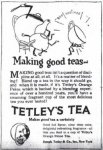
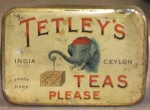
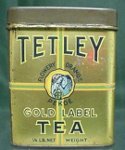
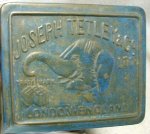 [15]
Tea merchants
[15]
Tea merchants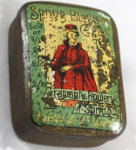
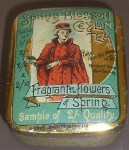 Cave Johnson & Co, originally of 8 Lime Street in the City, sold tea and coffee. In 1883 Health - A weekly journey of Sanitary Health advertised 'Bonne-Bouche' coffee (used once, used always) as an
agreeable beverage ... of pure and wholesome character. It consists of
an admixture of Bruges chicory and pure coffee only, and may,
therefore, be relied upon as a safe and and nutritious article of
dietary. The coffee has a highly agreeable taste and pleasant aroma,
and will well repay a trial. It was sold in tin canisters at 1s. and 1s. 4d. per lb. In 1887 'Spring Blossom' Ceylon Tea was promoted as effectively
labelled, but not bearing the name of the firm, is an excellent article
for chemists' sale. It is a tea of remarkably fine flavour, likely to
secure a lasting reputation, and in and in these air-tight tins will
neither deteriorate nor absorb other flavours, considerations of no
small importance to chemists and druggists. Two tins, with 'Shakespeare's Venice' motif, shown left. The
fact that in 1921 they shared premises with Tetley's suggests that they
were working together, or perhaps this small firm had been taken over.
Cave Johnson & Co, originally of 8 Lime Street in the City, sold tea and coffee. In 1883 Health - A weekly journey of Sanitary Health advertised 'Bonne-Bouche' coffee (used once, used always) as an
agreeable beverage ... of pure and wholesome character. It consists of
an admixture of Bruges chicory and pure coffee only, and may,
therefore, be relied upon as a safe and and nutritious article of
dietary. The coffee has a highly agreeable taste and pleasant aroma,
and will well repay a trial. It was sold in tin canisters at 1s. and 1s. 4d. per lb. In 1887 'Spring Blossom' Ceylon Tea was promoted as effectively
labelled, but not bearing the name of the firm, is an excellent article
for chemists' sale. It is a tea of remarkably fine flavour, likely to
secure a lasting reputation, and in and in these air-tight tins will
neither deteriorate nor absorb other flavours, considerations of no
small importance to chemists and druggists. Two tins, with 'Shakespeare's Venice' motif, shown left. The
fact that in 1921 they shared premises with Tetley's suggests that they
were working together, or perhaps this small firm had been taken over.
[16] The story of Faircloughs is told here. By 1921 their description as wheelwrights was distinctly anachronistic!
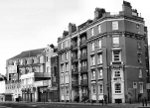
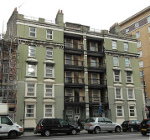
 [17] The Improved Industrial Dwellings Company Ltd (see here for background) erected two similar blocks of dwellings on opposite sides of the street
in 1874; they were named after Walter Morrison MP, the chairman. In 1899 there was a resident carpenter, George Plumby. The
one on the north (35a) still stands [left, two views]; that on the south [right in 1972], comprising flats 1-54 and
54 a, b, c & d, is now demolished. In 1928 the company successfully
appealed against assessing each flat separately for tax purposes under
the Valuation (Metropolis) Act 1869, rather than as two 'entire houses
or tenements' - see the Master of the Rolls' judgement in the Court of
Appeal, Towle (Inspector of Taxes) v IIDC Ltd [1931] KB 264.
[17] The Improved Industrial Dwellings Company Ltd (see here for background) erected two similar blocks of dwellings on opposite sides of the street
in 1874; they were named after Walter Morrison MP, the chairman. In 1899 there was a resident carpenter, George Plumby. The
one on the north (35a) still stands [left, two views]; that on the south [right in 1972], comprising flats 1-54 and
54 a, b, c & d, is now demolished. In 1928 the company successfully
appealed against assessing each flat separately for tax purposes under
the Valuation (Metropolis) Act 1869, rather than as two 'entire houses
or tenements' - see the Master of the Rolls' judgement in the Court of
Appeal, Towle (Inspector of Taxes) v IIDC Ltd [1931] KB 264.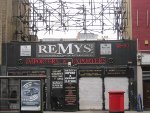 [18] The mohel
- a religious official who performs circumcisions (sometimes a rabbi
or cantor, sometimes medically trained) was presumably attached to the Beltz
synagogue a few doors away, now demolished [site today, right].
[18] The mohel
- a religious official who performs circumcisions (sometimes a rabbi
or cantor, sometimes medically trained) was presumably attached to the Beltz
synagogue a few doors away, now demolished [site today, right].
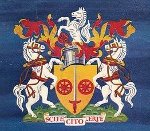 [19] Arthur
Bentley Murray and Arthur John Laker traded as Murray & Laker, shipping and custom
house agents and licensed carriers, with premises here (where William James Murray had previously operated as a carman) - in 1920 they
registered the freehold on dwelling houses, stabling, cart sheds, buildings, yard and gardens
at 68 Commercial Road and 1 Sander Street (the road behind) - and at
26-27 Tower Hill. Murray retired in 1934 (he was also a director of
Arnold & Murray, merchants of 139 Cannon Street EC4, and of several
rubber companies); he lived in Streatham. Laker, who lived in Reigate,
retired in 1952, aged 80. He was a freemason (Master of Walthamstow
Lodge in 1919) and Master for 1938 of the Worshipful Company of Carmen
(founded 1577), for whom that year a new badge was designed by
the Lancaster Herald, Archibald G.B. Russell MVO. His sons Arthur
Edward and John Frederick continued the business, moving to 90 and
later 57 Minories, where in 1970 they advertised Oak Vats for wines, spirits, cider, etc., improved design to minimise evaporation.
[19] Arthur
Bentley Murray and Arthur John Laker traded as Murray & Laker, shipping and custom
house agents and licensed carriers, with premises here (where William James Murray had previously operated as a carman) - in 1920 they
registered the freehold on dwelling houses, stabling, cart sheds, buildings, yard and gardens
at 68 Commercial Road and 1 Sander Street (the road behind) - and at
26-27 Tower Hill. Murray retired in 1934 (he was also a director of
Arnold & Murray, merchants of 139 Cannon Street EC4, and of several
rubber companies); he lived in Streatham. Laker, who lived in Reigate,
retired in 1952, aged 80. He was a freemason (Master of Walthamstow
Lodge in 1919) and Master for 1938 of the Worshipful Company of Carmen
(founded 1577), for whom that year a new badge was designed by
the Lancaster Herald, Archibald G.B. Russell MVO. His sons Arthur
Edward and John Frederick continued the business, moving to 90 and
later 57 Minories, where in 1970 they advertised Oak Vats for wines, spirits, cider, etc., improved design to minimise evaporation.
[20] Photographers
 Henry Shaw called
his premises, at 76-78, the Rembrandt Studio; there are various
extant photos of bar mitzvahs (including Benjamin, son of Isaac Frankel
('Reb Itchele'), beadle of Artillery Lane synagogue), family groups and
recent immigrants (including Sophie and Nathan Ornstein from Rumania).
Henry Shaw called
his premises, at 76-78, the Rembrandt Studio; there are various
extant photos of bar mitzvahs (including Benjamin, son of Isaac Frankel
('Reb Itchele'), beadle of Artillery Lane synagogue), family groups and
recent immigrants (including Sophie and Nathan Ornstein from Rumania).
Oscar Baumgart's
studio, established in 1896, was The Empire Day and Electric Light
Studios. (Otto Baumgart was based nearby, at 12 Little Alie Street,
from 1897-98.) John Woodeson in Mark Gertler: biography of a painter, 1891-1939 (Sidgwick & Jackson 1972), describes Gertler's bar mitzvah when he was 13:
At the little party later he made the customary speech thanking his
parents for all they had done. His speech pleased everyone and and its
unusual eloquence made a deep impression on his brothers and sisters.
Afterwards they trooped off to Oscar Baumgart's photographic studio in
Commercial Road ... [Right is Gertler's self-portrait of 1920; other artists of the group known as the 'Whitechapel Boys' were Isaac Rosenberg and David Bomberg].
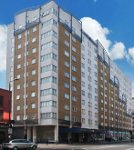 [21] Abraham and Morris Hildebrand, trading as A. & M. Hildebrand, woollen merchants of
80 Commercial Road (to which they registered freehold title of a shop and dwelling house in 1920)
and 4 Redcross Street, went bankrupt in 1930 but were released the following year. Today the site is
occupied by the Skyline Plaza [right].
[21] Abraham and Morris Hildebrand, trading as A. & M. Hildebrand, woollen merchants of
80 Commercial Road (to which they registered freehold title of a shop and dwelling house in 1920)
and 4 Redcross Street, went bankrupt in 1930 but were released the following year. Today the site is
occupied by the Skyline Plaza [right].
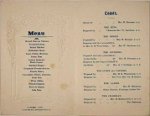 [22] Printers
[22] Printers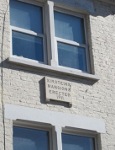 Here and elsewhere in the parish there was a good number of printers at work. Pomerantz & Duransky were at no.82, and Joseph Morris (with his wife Polly) at no.154.
Here and elsewhere in the parish there was a good number of printers at work. Pomerantz & Duransky were at no.82, and Joseph Morris (with his wife Polly) at no.154.
At no.208 was Simon Tolovinsky
who printed this menu for the 25th anniversary banquet and ball of the
Manasseh ben Israel Friendly Society (of which he was a brother), at the Devonshire Hall, Hackney.
In 1930 Newspaper World described him as a master printer,
reporting a judgement against him of £28 8s. By 1956 it had become The
Tolvin Press, and by 1970 it had moved to Leytonstone.
Wedding stationery was
also printed at the junction with White
Church Lane, by Kirsteins who moved into the property market and built this 'mansion' there in 1911- right.
[23] Wine & spirit merchants
Joseph Wodislawsky
was born in Russia, and naturalized in 1900 (living at 33 Walden
Street, Stepney). In 1921 he registered the freehold of 88, 90 and 92
Commercial Road East and Coopers Hall at the back of 88 and 90 and was
in business as a wine & spirit merchant, trading with his sons
Simon Elkan and Isaac Harry as the National Wine & Spirit Company,
and also as J Wodislawski & Sons; he retired in 1933. The premises,
adjacent to the synagogue (above) are now demolished.

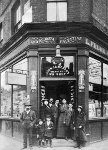
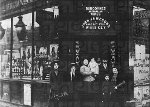 At 162-164,
on the corner with Cannon Street
Road,
was Frumkins, 'The House for
Weddings' - a wholesale and retail wine,
spirit and liquor merchants [right, in ??, 1914 and c1947]. Its story,
with more pictures, is told here and here.
The proprietor was
the grandmother of Chief Rabbi (Lord) Jonathan Sacks,
who in his 2013 Passover message recalls how she would give needy Jews
a bottle of wine so that their families could have the four cups for
Seder night (in accordance with the custom of ma'ot chittim,
giving help to those who needed it to get the requisites for the meal).
In 1921, Elias and Rachael Frumkin lived at 46a Upper Clapton Road, and
Zachariah and Rachel Dimson on the premises.
At 162-164,
on the corner with Cannon Street
Road,
was Frumkins, 'The House for
Weddings' - a wholesale and retail wine,
spirit and liquor merchants [right, in ??, 1914 and c1947]. Its story,
with more pictures, is told here and here.
The proprietor was
the grandmother of Chief Rabbi (Lord) Jonathan Sacks,
who in his 2013 Passover message recalls how she would give needy Jews
a bottle of wine so that their families could have the four cups for
Seder night (in accordance with the custom of ma'ot chittim,
giving help to those who needed it to get the requisites for the meal).
In 1921, Elias and Rachael Frumkin lived at 46a Upper Clapton Road, and
Zachariah and Rachel Dimson on the premises.

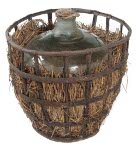
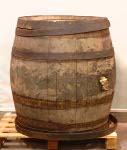


 Mendel
Chaikin was born in Russia in 1871, as was his wife and her mother;
their first two children were born in Jerusalem and others in London.
From the 1890s his firm Mendel Chaikin & Co
imported Israeli wine (they were the first to import from the cellars
of Petach Tikvah, founded in 1903), and produced their own kosher wine
and spirits, using dried fruit instead of grapes, in the basement of
Brick Lane Great Synagogue, with a shop at 72-74; they expanded to 228
Commercial Road and Sandringham Road, Dalston. Pictured are various
items from their premises, now at the Museum of London - a pressing
vat, a carboy, a barrel, a corking machine, a stamp and some mead
labels. Their trademark was 'Bozwin' (Beauty of Zion Wine). In 1933
they were awarded a Diploma of Merit for their display at the
Anglo-Palestine Exhibition in London. At that stage Bernard Lewis
Deichowsky (c1874-1945) headed the firm; he was President of the
Synagogue for 37 years, and his father-in-law Abraham Werner was the
rabbi. They ceased trading in 1976.
Mendel
Chaikin was born in Russia in 1871, as was his wife and her mother;
their first two children were born in Jerusalem and others in London.
From the 1890s his firm Mendel Chaikin & Co
imported Israeli wine (they were the first to import from the cellars
of Petach Tikvah, founded in 1903), and produced their own kosher wine
and spirits, using dried fruit instead of grapes, in the basement of
Brick Lane Great Synagogue, with a shop at 72-74; they expanded to 228
Commercial Road and Sandringham Road, Dalston. Pictured are various
items from their premises, now at the Museum of London - a pressing
vat, a carboy, a barrel, a corking machine, a stamp and some mead
labels. Their trademark was 'Bozwin' (Beauty of Zion Wine). In 1933
they were awarded a Diploma of Merit for their display at the
Anglo-Palestine Exhibition in London. At that stage Bernard Lewis
Deichowsky (c1874-1945) headed the firm; he was President of the
Synagogue for 37 years, and his father-in-law Abraham Werner was the
rabbi. They ceased trading in 1976.
[24] Medics
The
doctors and physicians of Commercial Road were mainly Jewish (or,
further east, Irish). But antisemitism was rampant in some medical schools - notably, and surprisingly, at
the London Hospital (though not at the Middlesex) - see John
Cooper Pride versus Prejudice: Jewish Doctors and Lawyers in England 1890-1990 (Littman
Library of Jewish Civilisation 2003). Yet there were Jewish wards at
the London, described by Montagu Williams QC in ch.6 of Round London: Down East and Up West (1894):
| Two of the wards are specially endowed by the Rothschild family for the use of Jews. They are in every way distinct from the rest of the establishment, and have their own kitchens and cooks. In these wards the Jewish Sabbath is kept, the Passover is celebrated with the greatest solemnity, and all the fasts and feasts of this ancient race are duly observed ... These Hebrew patients are, as a rule, very well-conducted people. Though the race to which they belong is notoriously slow to part with money, it invariably happens that, when anybody is dying in these wards, some one is found to defray the cost of a 'watcher'. This individual remains by the bedside until death takes place, and performs the necessary offices afterwards. Christian nurses are not permitted to touch the body; everything is left to the 'watcher'. Another peculiarity of this most peculiar people is that they will not eat from a plate that has been previously used by Christians. What is more, it is insisted that no plate from which a Jew has eaten shall leave the ward until it has been washed. The strangest part of the business is that the nurses themselves are Christians. The patients would not on any account permit one of their own race to give them their draughts and otherwise minister to them ... As they speak nothing but Yiddish, they find it very difficult to make themselves understood, but by hook or by crook they manage to express the grateful feelings they almost invariably entertain towards their nurses. |
 Dr Samuel Spigner (1880-1946)
registered the freehold of 100 Commercial Road and 1 & 1a Batty
Street in 1921, and practised there. In 1888 Dr Frederick William Blackwell, at this
address, had been the first doctor to be summoned by the police to the
body of Elizabeth Stride nearby (Dr Marcus Cohen shared the practice around 1907). Right is a doorway from the side of this house.
Dr Samuel Spigner (1880-1946)
registered the freehold of 100 Commercial Road and 1 & 1a Batty
Street in 1921, and practised there. In 1888 Dr Frederick William Blackwell, at this
address, had been the first doctor to be summoned by the police to the
body of Elizabeth Stride nearby (Dr Marcus Cohen shared the practice around 1907). Right is a doorway from the side of this house.(In 1899 there was also Drs Sargent & Sargent at no.300, William Grandy at no.314 and Alex Grant at no.370.)
[25] Morris Petrikoski,
also known as Isaac Patrokowsky, was naturalized in 1925 and changed
his name by deed poll to Maurice Petrie. The butcher's shop was
previously run by John Henry Tirrell, at a time when there were several
more butchers, both kosher and non-kosher, along the road.
[26] Isaac Kahan first set up here as a money changer, with John Zaussman as his assistant. Then he was in partnership with
sons Boris, Louis Moses and Leon Kahan as I. Kahan & Co, shipping, banking & commission agents
(working particularly with White Star & Cunard) until Louis and
Leon left it in 1910. The family lived at 6 Clapton Square,
Hackney. Jews were well-represented among the various socialist,
communist and anarchist parties of this period, as right-wing
antisemitic commentators are quick to point out, and although Isaac was
probably not politically active, three of his children certainly were:
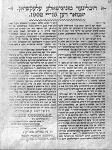 Boris
(1877-1951), born in Kiev, was the Secretary of the East London
(Jewish) branch of the Social Democratic Federation (SDF), and met
Lenin on his first visit to the East End in 1903. In the previous year
he had produced a leaflet in Yiddish (right; translation here) for James Connolly
who ran as a Socialist candidate for Dublin Corporation in the Wood
Quay Ward, which included a large Jewish population in the Iveagh Trust
Buildings and parts of Portobello; thanks to Boris' efforts, he came
third with 431 votes. Connolly was executed for his part in leading the
1916 rising: see Donal Nevin James Connolly: a full life (Gill & Macmillan 2005)
Boris
(1877-1951), born in Kiev, was the Secretary of the East London
(Jewish) branch of the Social Democratic Federation (SDF), and met
Lenin on his first visit to the East End in 1903. In the previous year
he had produced a leaflet in Yiddish (right; translation here) for James Connolly
who ran as a Socialist candidate for Dublin Corporation in the Wood
Quay Ward, which included a large Jewish population in the Iveagh Trust
Buildings and parts of Portobello; thanks to Boris' efforts, he came
third with 431 votes. Connolly was executed for his part in leading the
1916 rising: see Donal Nevin James Connolly: a full life (Gill & Macmillan 2005)Boris
Kahan and Theodore Rothstein were key figures in bringing the BSP /
CPGB into the fold of the Leninist Third International. There is an
extensive literature on whether or not they and others propelled the
British socialist cause in a direction which the majority did not want,
reviewed in this thesis on Rothstein.
[27] John Walker Bland established J.W. Bland & Sons, wholesale stationers; John Percival Bland and Horace Streachan Bland ran the firm in partnership until Horace retired in 1932.
[28]
Furniture makers & dealers
In the mid-19th century, 'garret masters' entered the furniture-making
trade to supply the growing needs of the capital, with several thousand
working from small rooms and attics, buying wood for one piece at a
time, with their many children providing labour. Jewish immigrants came
to dominate this trade. By the turn of the century, firms had got
bigger (Lebus relocated from Tabernacle Street to Tottenham Hale in
1903, employing 1,000 people), and well-known emporia resulted, such as
Lobovitch, Hyman, Galinsky and Dolnisky on the Whitechapel Road, or
Wickhams, 'the Harrods of East London', at Mile End. Israel Metz, traded from no.124, living there with his sons Hyman Harris and Solomon, and Percy Young
from larger premises at no.196-8, living with his Annie in Westcliff-on-Sea. The coming of
utility furniture during the Second World War ended this pattern: firms
went under, both small and large (including Lebus and Beautility). See here for a picture of 196-200 Commercial Road in 1967, after demolition.
(At the turn of the century there was also Grosman & Pinsky at no.238 and Levene Margolinski at no.264.)
[29] Abraham Rosnick shortened his name to Ross.
[30] from nos.138-148 there are no names on the 1921 electoral roll (except for the pub), indicating that none of these traders lived 'over the shop'.
[31] Sidney Stebbings,
who lived at Dunsmore Road, Stoke Newington, was in partnership with
Harris Rosenberg, who lived at 61 Berner Street. His original surname
was Stebbinski - there are archive photos of Becky
Stebbinski/Stebbings with her sister Fanny (both née Yulitsky,
from Suwałki in north-eastern Poland) and later with her son Michael Stebbings at
his 1920 bar mitzvah. Sidney was still trading here in the 1950s.
[32] Harris
Krayer was from Russia, naturalised in 1903. He was a member of the New
Synagogue (between Crosby Place and St Helen's Square in the City) and
worked as a draper, originally with one Greenberg. He had financial difficulties in 1907 but these
were resolved three years later. S Krayer
was wife Sarah; by this time they were living at Walm Lane in
Cricklewood, while Gustave and Bella Churcher were resident at the
Commercial Road address.
[33] Alick Brass, né Aleck Moruse, was born in Warsaw in 1883 and naturalized in 1923, described as a costumier.
[34] Joseph Oseas Rosenfeld was born in Roumania in 1878 and naturalized in 1946, known then as Joe Oseas Rose, and a confectioner, toboacconist and newsagent in Bedford Road, Clapham. In 1921 Bella Berliner occupied the Commercial Road premises.
[35] Banks
Lloyds Bank began in Birmingham in 1765, with its first branch office
at Oldbury in 1864, becoming incorporated as a joint-stock company,
Lloyds Banking Company Ltd., the following year. (It is unconnected
with the activities that began at Lloyd's Coffee House in the City -
the List and the Register.) The black horse became its symbol in 1884,
taken from a bank absorbed into the company one of whose founders had
used it as a sign for his goldsmith's shop. Further takeovers followed
(including Cunliffe, Brooks in 1900, the Wilts and Dorset Bank in 1914
and Capital & Counties Bank in 1918) - by 1923 there had been 50,
including the last private firm to issue its own banknotes (Fox, Fowler
& Co of Wellington, Somerset). Its later and complex story can be
read here.
Barclays Bank
began in Lombard Street in 1690, as goldsmith bankers, at 54 Lombard
Street from 1728 (at the sign of the black spread eagle); James Barclay
became a partner in 1736. In 1896 it became Barclays & Co, a
joint-stock bank, and over the next few years acquired a number of
smaller banks, including in 1918 the London, Provincial and South
Western Bank, which as the London and South Western Bank Ltd from 1862-1917 had run the Commercial Road branch. See here for Barclays' later history. These premises later housed the London Trustee Savings Bank.
[36] Thomas Rose Crouch was the superintendent chaplain of the Mariners' Friend Society for over 50 years until his death, at Bank House, 210 Commercial Road in 1921; its head office was in Old Gravel [now Wapping] Lane - more about him and the Society here.
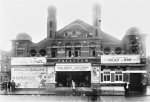

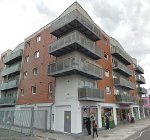
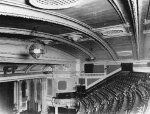 [37] Feinman's
Yiddish Theatre, named after Sigmund Feinman, a popular Yiddish actor, was built as a 'Temple of Arts' in Moorish style
(originally with three domes), seating 1,000. It opened in 1912 with
productions of King Ahab and Rigoletto; but six months later it was
screening films and was renamed the Palaseum Cinema. A series of takeovers followed: United Picture Theatres in 1928 [left],
Gaumont British Theatres in 1930, Associated British Cinemas in 1934/5,
Southan Morris Super Cinemas (Essoldo Circuit) in 1954, closing in 1960
only to re-open as the Essoldo from 1961-66, then reverting to its
original name and screening Bollywood films until
[37] Feinman's
Yiddish Theatre, named after Sigmund Feinman, a popular Yiddish actor, was built as a 'Temple of Arts' in Moorish style
(originally with three domes), seating 1,000. It opened in 1912 with
productions of King Ahab and Rigoletto; but six months later it was
screening films and was renamed the Palaseum Cinema. A series of takeovers followed: United Picture Theatres in 1928 [left],
Gaumont British Theatres in 1930, Associated British Cinemas in 1934/5,
Southan Morris Super Cinemas (Essoldo Circuit) in 1954, closing in 1960
only to re-open as the Essoldo from 1961-66, then reverting to its
original name and screening Bollywood films until
1985 [second left, shortly after closure]. The 2008 building on the site [right] includes a Tesco Express.
 [38] In 1899 John Byford, born in 1860 in Canning Town, took his young son John into partnership as John Byford & Son, lime, cement and brick merchants, manufacturing and dealing in bricks and building requisites of all kinds
at Moody Wharf, Poplar and Commercial Road. It became a limited company
in 1911, with £25,000 capital in £1 shares. John senior was also the
chairman of the oddly-named British & Colonial Horse Shoe and
Machine Company (actually hauliers, and still active during World War
II). He was a member of West Ham Council from 1898 and Mayor in 1904-5,
a Justice of the Peace, and vice-president of Queen Mary's Hospital for the East End, in West Ham [right].
He had served in the Royal Naval Volunteers and held a commission in
the 3rd Essex Battalion Volunteers, and during World War I was active
in local recruiting committees; he was knighted in 1925, by when he was
living at Wedderburn Road in Hampstead; he died in 1931. Who was Who
gives his recreations as yachting and swimming, and his club the
Constitutional. The firm were agents for Griffin Brand Portland cement,
and continued to supply local councils and others for some years.
The National Maritime Museum has their 'house flag' - a rectangular blue flag, with a white triangle placed near the hoist bearing a red Welsh dragon.
[38] In 1899 John Byford, born in 1860 in Canning Town, took his young son John into partnership as John Byford & Son, lime, cement and brick merchants, manufacturing and dealing in bricks and building requisites of all kinds
at Moody Wharf, Poplar and Commercial Road. It became a limited company
in 1911, with £25,000 capital in £1 shares. John senior was also the
chairman of the oddly-named British & Colonial Horse Shoe and
Machine Company (actually hauliers, and still active during World War
II). He was a member of West Ham Council from 1898 and Mayor in 1904-5,
a Justice of the Peace, and vice-president of Queen Mary's Hospital for the East End, in West Ham [right].
He had served in the Royal Naval Volunteers and held a commission in
the 3rd Essex Battalion Volunteers, and during World War I was active
in local recruiting committees; he was knighted in 1925, by when he was
living at Wedderburn Road in Hampstead; he died in 1931. Who was Who
gives his recreations as yachting and swimming, and his club the
Constitutional. The firm were agents for Griffin Brand Portland cement,
and continued to supply local councils and others for some years.
The National Maritime Museum has their 'house flag' - a rectangular blue flag, with a white triangle placed near the hoist bearing a red Welsh dragon.
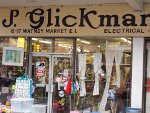 [40] The partnership between Morris (born in Russia in 1857) and Harris
Glickman, trading as M & H Glickman, ironmongers, and as 'H
Glickman' at 4 Broadway Market, Ilford was dissolved in 1921. By the 1960s their shop was at 238, shown here; it is now in Watney Market [right], and Muslim-run.
[40] The partnership between Morris (born in Russia in 1857) and Harris
Glickman, trading as M & H Glickman, ironmongers, and as 'H
Glickman' at 4 Broadway Market, Ilford was dissolved in 1921. By the 1960s their shop was at 238, shown here; it is now in Watney Market [right], and Muslim-run.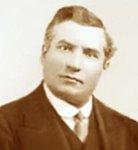
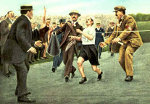
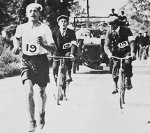 [41] Letterio (Lillo) Saitta (1875-1926), left, was a music teacher and composer. In 1908 he published two topical items: Messina, an opera about the earthquake of that year (its overture is still occasionally performed), and a Grand March for piano, Dorando - The Hero of the Marathon Race, of which recordings are extant. Dorando Pietri,
a 5' 2" Italian pastry chef, came first in the marathon at the London
Olympics that year but was disqualified because umpires had helped him
up when he stumbled [right] - more detail here. (Irving Berlin also wrote a song about him, with embarrassingly cod-Italian lyrics.) In 1915 Saitta published Viva l'Italia! Nuovo inno patriottico, setting his own words to music. His Surrey-born wife was Florence Rose Compton.
[41] Letterio (Lillo) Saitta (1875-1926), left, was a music teacher and composer. In 1908 he published two topical items: Messina, an opera about the earthquake of that year (its overture is still occasionally performed), and a Grand March for piano, Dorando - The Hero of the Marathon Race, of which recordings are extant. Dorando Pietri,
a 5' 2" Italian pastry chef, came first in the marathon at the London
Olympics that year but was disqualified because umpires had helped him
up when he stumbled [right] - more detail here. (Irving Berlin also wrote a song about him, with embarrassingly cod-Italian lyrics.) In 1915 Saitta published Viva l'Italia! Nuovo inno patriottico, setting his own words to music. His Surrey-born wife was Florence Rose Compton.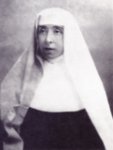 [45] The Little Company of Mary is a Roman Catholic community of sisters founded by Mary Potter [right] in
Nottingham to nurse and pray for the sick and dying; it established
houses elsewhere in this country and overseas, including Commercial
Road from 1896-1933. (Mother Ethelreda was the first superior here.) Mary Potter died in 1913, and in 1988 was declared
'Venerable' - the first stage towards canonisation as a saint.
[45] The Little Company of Mary is a Roman Catholic community of sisters founded by Mary Potter [right] in
Nottingham to nurse and pray for the sick and dying; it established
houses elsewhere in this country and overseas, including Commercial
Road from 1896-1933. (Mother Ethelreda was the first superior here.) Mary Potter died in 1913, and in 1988 was declared
'Venerable' - the first stage towards canonisation as a saint. [47] Four generations of the family led the firm of Frost Bros,
first established in 1790. The founder's son James John died in 1862
and four of his sons, James John (d.1899), Frederick (d.1901), Charles
(d.1896) and Albert John (d.1902 - he was Deputy Chairman of the Merchant Seamen's Orphan Asylum),
continued the business. A fire destroyed the factory in 1860; it was
rebuilt the following year, and in 1896 a spinning house and rope store
was added, designed by T.W. Aldwinckle, architect of a large number of
municipal buildings; this increased their capacity from 40 to 120 tons
of rope a wek (plus spinning 100 tons of yarn). In the 1889 local
women had formed their own branch of the Ropemakers' Union (which had
been formed with the help of the Women's Trade Union Association
following a meeting at the Dean Street Mission room by permission of
the Vicar of Christ Church, Marmaduke Hare)
and the following year went on strike, demanding a wage of 2d. an hour
for the lowest grade, 2¼d. for the next, and 2½d. for the highest grade
of work, equal to what other local ropemakers were paying (it would
have increased the company's wage bill by £7 a week).
[47] Four generations of the family led the firm of Frost Bros,
first established in 1790. The founder's son James John died in 1862
and four of his sons, James John (d.1899), Frederick (d.1901), Charles
(d.1896) and Albert John (d.1902 - he was Deputy Chairman of the Merchant Seamen's Orphan Asylum),
continued the business. A fire destroyed the factory in 1860; it was
rebuilt the following year, and in 1896 a spinning house and rope store
was added, designed by T.W. Aldwinckle, architect of a large number of
municipal buildings; this increased their capacity from 40 to 120 tons
of rope a wek (plus spinning 100 tons of yarn). In the 1889 local
women had formed their own branch of the Ropemakers' Union (which had
been formed with the help of the Women's Trade Union Association
following a meeting at the Dean Street Mission room by permission of
the Vicar of Christ Church, Marmaduke Hare)
and the following year went on strike, demanding a wage of 2d. an hour
for the lowest grade, 2¼d. for the next, and 2½d. for the highest grade
of work, equal to what other local ropemakers were paying (it would
have increased the company's wage bill by £7 a week). | The greatest attention must be paid to ropes, as fatalities due to the breakage of these have been very numerous. I was, in
consequence, induced to institute some very careful inquiries into the
question of the most suitable ropes for alpine work, and some very
exhaustive tests were thereupon made of various ropes by Mr. O.
Eckenstein, which have been confirmed by subsequent tests made by Swiss
climbers. The result was the evolution of a flax rope, which, in point
of ultimate tensile strength and extension (i.e. elasticity), surpasses
considerably any other rope, weight for weight ... Frost's
left-hand alpine rope ... is beautifully flexible to handle and knot,
and after the first wetting shows no tendency to kink. I do not know
much of its wearing capacities; in this respect it is probably excelled
by the harder Manila ropes. For the haulage of duffers where the rope
is constantly dragged against rocks, no doubt a much heavier rope of
Manila or possibly wire would be preferable. The Frost rope now
described is designed for the use of trained mountaineers. All that I
demand and all that ought to be demanded of an alpine rope is that it
shall not show undue wear during a single season. I never use for a
second season a rope on which life may depend when a new one can be
obtained for a few shillings.
Even when a rope shows no appreciable wear, it may have been subjected
to some sudden severe strain which has robbed it of a portion of its
virtue. I go so far as to say that used ropes ought not to be given
away to guides who will go on using them for an indefinite time. |
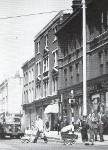 [49] In 1861, at an Old Bailey case where James Briggs
was acquitted of receiving stolen goods (glass paper, emery cloth,
glue, paper and labels), Edmund Richard Goodrich described himself as
an oilman [a supplier of oil for lamps] in business at 64 Church Lane, Whitechapel. In 1853 he had been appointed an Alderman of Christ's Hospital.
By the time of his death in 1897, living at a villa which he named 'Stebenheath' [the old name
for Stepney!] in Vanburgh Park Road West, Blackheath, he was described as
a wholesale & retail oil and colourman
[one who mixed and provided textile dyes] and had shops in Whitechapel, Old Kent Road,
Kennington, New Cross, Hackney, Mile End Old Town, Bow Road as well as
Commercial Road (27 & 354). These were in effect grocer's shops -
the business was so described in 1914 when it was incorporated as Edmund R Goodrich Ltd - but locals near his Bermondsey shop [right] apparently still referred to it as 'the oil shop'. His son Alfred Ordway Goodrich (1862-1936) continued the business as a wholesale oilman and produce merchant, and was a local politician, elected to the London County Council for the Municipal Reform Party
at by-elections in 1902 and 1905 (the peak of their influence: the
party existed from 1894-1963), and serving as a councillor until 1928,
for Stepney, then Mile End, then as an alderman; he lived in Bow before
moving to Buckhurst Hill. The company continues, but in name only, from
a trading address in Forest Gate.
[49] In 1861, at an Old Bailey case where James Briggs
was acquitted of receiving stolen goods (glass paper, emery cloth,
glue, paper and labels), Edmund Richard Goodrich described himself as
an oilman [a supplier of oil for lamps] in business at 64 Church Lane, Whitechapel. In 1853 he had been appointed an Alderman of Christ's Hospital.
By the time of his death in 1897, living at a villa which he named 'Stebenheath' [the old name
for Stepney!] in Vanburgh Park Road West, Blackheath, he was described as
a wholesale & retail oil and colourman
[one who mixed and provided textile dyes] and had shops in Whitechapel, Old Kent Road,
Kennington, New Cross, Hackney, Mile End Old Town, Bow Road as well as
Commercial Road (27 & 354). These were in effect grocer's shops -
the business was so described in 1914 when it was incorporated as Edmund R Goodrich Ltd - but locals near his Bermondsey shop [right] apparently still referred to it as 'the oil shop'. His son Alfred Ordway Goodrich (1862-1936) continued the business as a wholesale oilman and produce merchant, and was a local politician, elected to the London County Council for the Municipal Reform Party
at by-elections in 1902 and 1905 (the peak of their influence: the
party existed from 1894-1963), and serving as a councillor until 1928,
for Stepney, then Mile End, then as an alderman; he lived in Bow before
moving to Buckhurst Hill. The company continues, but in name only, from
a trading address in Forest Gate.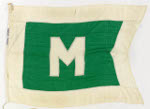 [50] Charles Crawley, lighterman, barge owner and contractor,
of no.370 and of 285 Burdett Road, Limehouse (formerly at 32 Old Gravel
Lane), founded his business in 1893, working out of Gravesend and
elsewhere; he died in 1916. Thomas Metcalf was the manager, and after
World War I bought 'X lighter' ships which had been used as landing
craft. In 1923 the company was registered as C Crawley Ltd with £4,000
capital in £1 shares; Mrs E. Metcalf was the chairman, and Thomas the
managing director. In 1929 they bought the Frank M,
a coastal tanker. By 1943 Metcalf Motor Coasters Ltd had ten vessels,
and in 1952 purchased two Glasgow companies, increasing their fleet to
7 tankers and 14 coasters [house flag - at the National Maritine Museum - left]. It became Coe Metcalf Shipping by merger in the 1970s and was later acquired by James Fisher.
[50] Charles Crawley, lighterman, barge owner and contractor,
of no.370 and of 285 Burdett Road, Limehouse (formerly at 32 Old Gravel
Lane), founded his business in 1893, working out of Gravesend and
elsewhere; he died in 1916. Thomas Metcalf was the manager, and after
World War I bought 'X lighter' ships which had been used as landing
craft. In 1923 the company was registered as C Crawley Ltd with £4,000
capital in £1 shares; Mrs E. Metcalf was the chairman, and Thomas the
managing director. In 1929 they bought the Frank M,
a coastal tanker. By 1943 Metcalf Motor Coasters Ltd had ten vessels,
and in 1952 purchased two Glasgow companies, increasing their fleet to
7 tankers and 14 coasters [house flag - at the National Maritine Museum - left]. It became Coe Metcalf Shipping by merger in the 1970s and was later acquired by James Fisher. 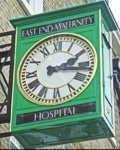
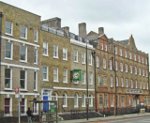 [52] In 1884 a 7-bed Mothers' Lying-In Home was established in Glamis Road by the author and columnist Lady Violet Greville, Louisa Beresford, Marchioness of Waterford (a pre-Raphaelite watercolourist), Mrs James Stuart Wortley and others, to
maintain in the East of London a Hospital (which is entirely
un-sectarian) for the treatment of poor married Women during
child-birth, also for training midwives and nurses for attendance on
the poor at their own homes. It was the only such facility in
the populous East End. Attendance for a home confinement, for those who
could not afford a stay, was 3s 6d. Renamed the East End Mother's Home,
in 1889 it moved to new premises (costing £600) at 396 Commercial Road [right - the blue door]
with 13 beds, mothers staying free of charge for up to a fortnight
after giving birth. Mrs Mabia Lily Ashton Warner was the superintendent. (At the Old Bailey in 1891 John William Haggerty, the dear old porter and handyman, was convicted of stealing and cashing supporters' cheques, for £1, 1 guinea and 5s.,
and some papers belonging to the Marchioness, and sentenced to nine
months' hard labour.) Further expansions followed - to 18 beds in 1897,
to 26 in 1903 (when it was renamed again as the East End Mothers' Lying-In Home),
and to 33 beds in 1907/8 with the addition of no.398. The walls were
painted green and each bed had a swing cot attached; there was a small
garden. No.394 was then acquired, but war (in which there was
some air-raid damage) delayed its opening until 1921; by 1925 there
were 41 beds (including the Pearly King ward, financed by the East
London Demonstration Committee). Ronnie Scott (1927-1996), the jazz musician, was born here in 1927. A
Needlework Guild provided 800 trousseaux a year, and about 80 mothers
attended weekly classes in mothercraft and hygiene. Finally, when the
SPCK college closed in 1926 nos.384-392 were added, giving a total of
56 beds, and it became the East End Maternity Hospital, administered by
the LCC from 1930 until it became part of the NHS. Its mortality rate
was half the national average of 1 per 1,000; by this time, the weekly
cost to mothers was around £3. During World War II the hospital was
evacuated and there was incendiary bomb damage. It finally closed in
1968 and is now the Steel's Lane Health Centre. The building (but not
the clock) is Grade II listed.
[52] In 1884 a 7-bed Mothers' Lying-In Home was established in Glamis Road by the author and columnist Lady Violet Greville, Louisa Beresford, Marchioness of Waterford (a pre-Raphaelite watercolourist), Mrs James Stuart Wortley and others, to
maintain in the East of London a Hospital (which is entirely
un-sectarian) for the treatment of poor married Women during
child-birth, also for training midwives and nurses for attendance on
the poor at their own homes. It was the only such facility in
the populous East End. Attendance for a home confinement, for those who
could not afford a stay, was 3s 6d. Renamed the East End Mother's Home,
in 1889 it moved to new premises (costing £600) at 396 Commercial Road [right - the blue door]
with 13 beds, mothers staying free of charge for up to a fortnight
after giving birth. Mrs Mabia Lily Ashton Warner was the superintendent. (At the Old Bailey in 1891 John William Haggerty, the dear old porter and handyman, was convicted of stealing and cashing supporters' cheques, for £1, 1 guinea and 5s.,
and some papers belonging to the Marchioness, and sentenced to nine
months' hard labour.) Further expansions followed - to 18 beds in 1897,
to 26 in 1903 (when it was renamed again as the East End Mothers' Lying-In Home),
and to 33 beds in 1907/8 with the addition of no.398. The walls were
painted green and each bed had a swing cot attached; there was a small
garden. No.394 was then acquired, but war (in which there was
some air-raid damage) delayed its opening until 1921; by 1925 there
were 41 beds (including the Pearly King ward, financed by the East
London Demonstration Committee). Ronnie Scott (1927-1996), the jazz musician, was born here in 1927. A
Needlework Guild provided 800 trousseaux a year, and about 80 mothers
attended weekly classes in mothercraft and hygiene. Finally, when the
SPCK college closed in 1926 nos.384-392 were added, giving a total of
56 beds, and it became the East End Maternity Hospital, administered by
the LCC from 1930 until it became part of the NHS. Its mortality rate
was half the national average of 1 per 1,000; by this time, the weekly
cost to mothers was around £3. During World War II the hospital was
evacuated and there was incendiary bomb damage. It finally closed in
1968 and is now the Steel's Lane Health Centre. The building (but not
the clock) is Grade II listed.Back to History | Back to Jewish Commercial Directory 1894 | Back to Jewish Presence (1) - Setlement